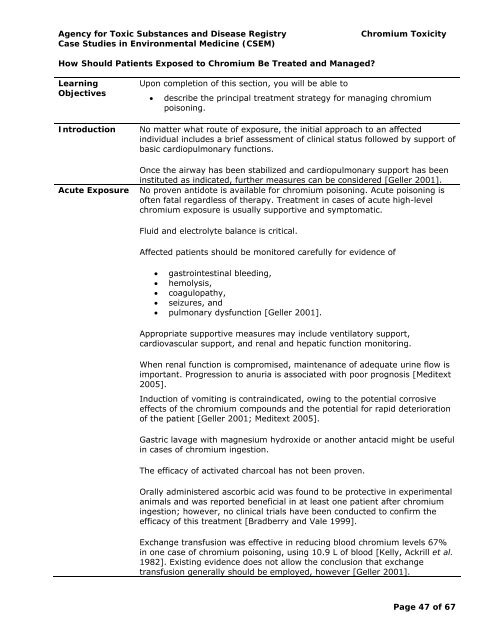(Cr) Toxicity | ATSDR - CSEM - Agency for Toxic Substances and ...
(Cr) Toxicity | ATSDR - CSEM - Agency for Toxic Substances and ...
(Cr) Toxicity | ATSDR - CSEM - Agency for Toxic Substances and ...
You also want an ePaper? Increase the reach of your titles
YUMPU automatically turns print PDFs into web optimized ePapers that Google loves.
<strong>Agency</strong> <strong>for</strong> <strong>Toxic</strong> <strong>Substances</strong> <strong>and</strong> Disease Registry Chromium <strong><strong>Toxic</strong>ity</strong><br />
Case Studies in Environmental Medicine (<strong>CSEM</strong>)<br />
How Should Patients Exposed to Chromium Be Treated <strong>and</strong> Managed?<br />
Learning<br />
Objectives<br />
Upon completion of this section, you will be able to<br />
• describe the principal treatment strategy <strong>for</strong> managing chromium<br />
poisoning.<br />
Introduction No matter what route of exposure, the initial approach to an affected<br />
individual includes a brief assessment of clinical status followed by support of<br />
basic cardiopulmonary functions.<br />
Once the airway has been stabilized <strong>and</strong> cardiopulmonary support has been<br />
instituted as indicated, further measures can be considered [Geller 2001].<br />
Acute Exposure No proven antidote is available <strong>for</strong> chromium poisoning. Acute poisoning is<br />
often fatal regardless of therapy. Treatment in cases of acute high-level<br />
chromium exposure is usually supportive <strong>and</strong> symptomatic.<br />
Fluid <strong>and</strong> electrolyte balance is critical.<br />
Affected patients should be monitored carefully <strong>for</strong> evidence of<br />
• gastrointestinal bleeding,<br />
• hemolysis,<br />
• coagulopathy,<br />
• seizures, <strong>and</strong><br />
• pulmonary dysfunction [Geller 2001].<br />
Appropriate supportive measures may include ventilatory support,<br />
cardiovascular support, <strong>and</strong> renal <strong>and</strong> hepatic function monitoring.<br />
When renal function is compromised, maintenance of adequate urine flow is<br />
important. Progression to anuria is associated with poor prognosis [Meditext<br />
2005].<br />
Induction of vomiting is contraindicated, owing to the potential corrosive<br />
effects of the chromium compounds <strong>and</strong> the potential <strong>for</strong> rapid deterioration<br />
of the patient [Geller 2001; Meditext 2005].<br />
Gastric lavage with magnesium hydroxide or another antacid might be useful<br />
in cases of chromium ingestion.<br />
The efficacy of activated charcoal has not been proven.<br />
Orally administered ascorbic acid was found to be protective in experimental<br />
animals <strong>and</strong> was reported beneficial in at least one patient after chromium<br />
ingestion; however, no clinical trials have been conducted to confirm the<br />
efficacy of this treatment [Bradberry <strong>and</strong> Vale 1999].<br />
Exchange transfusion was effective in reducing blood chromium levels 67%<br />
in one case of chromium poisoning, using 10.9 L of blood [Kelly, Ackrill et al.<br />
1982]. Existing evidence does not allow the conclusion that exchange<br />
transfusion generally should be employed, however [Geller 2001].<br />
Page 47 of 67

















